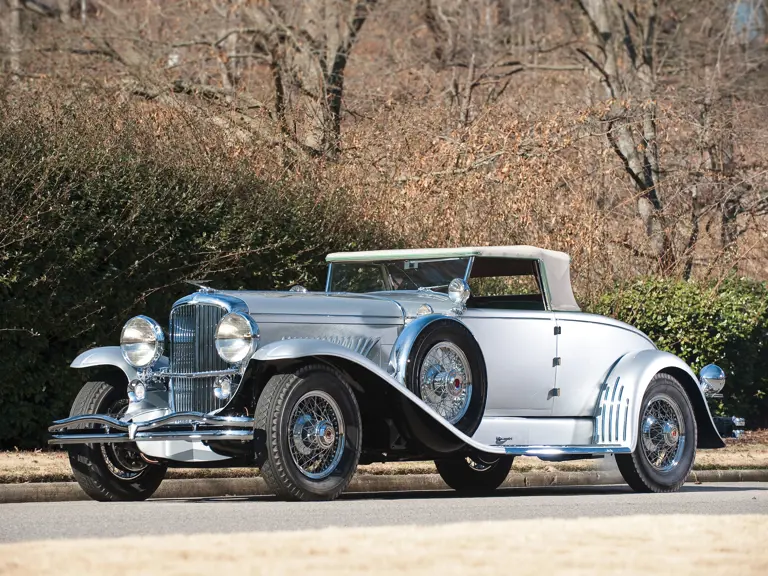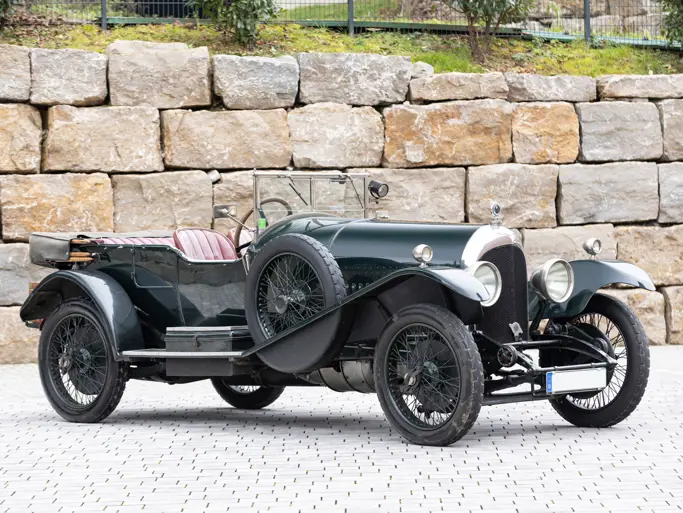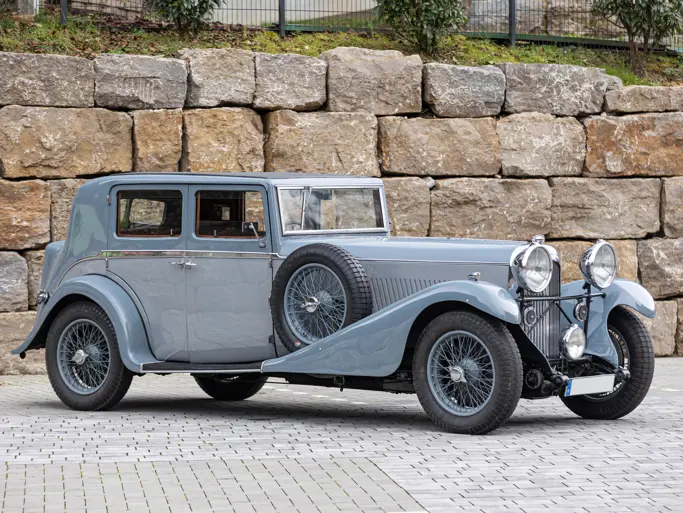
1929 Duesenberg Model J Convertible Coupe by Murphy
{{lr.item.text}}
$1,402,500 USD | Sold
{{bidding.lot.reserveStatusFormatted}}
- 420-cid, 265-hp straight eight-cylinder engine
- Three-speed manual transmission
- Coachwork by Murphy
- Popular and desirable Convertible Coupe
- Concours-quality restoration by Al Prueitt & Sons
- J-147 is ACD Club Certified Category One
- Pebble Beach Concours d’Elegance in 2009
- Amelia Award in 2011 for “Duesenberg – Open 1923 -1929”
- Exquisite and meticulously presented throughout
- CCCA Full Classic
- Known and interesting history
- 142-1/2 inch short wheelbase chassis
When J.L. Elbert wrote his groundbreaking book "Duesenberg: The Mightiest American Motor Car” in 1951, the Model J Duesenberg was only 23 years past its acclaimed December 1, 1928 introduction at the Auto Salon opening in New York. Mr. Elbert wrote in part: “It was a time of solid brass castings and engine-turned aluminum and stainless steel, of natural cowhide and quartered Circassian walnut, of hand-striped canework and whitewall tires white on both sides. Truly it was an honest day for product. Die-castings and synthetics are ubiquitous now. Veneered things are for the many. Those solid things were for the few. Here is a roaring saga out of the opulent Newport era – the Life and Times of an elegant motor car showpiece tailored for that few. Any car, deliberately designed to socially outrank others among patricians and at the same time competitively outdrive (89-mph in second gear) among playboys, would have to have been some automobile. That, Duesenberg was.” And so it remains.
The story of Fred and August Duesenberg along with E.L. Cord is among the most fascinating in automotive history. The Duesenbergs were self-taught mechanics and car builders whose careers started in the Midwest at the beginning of the twentieth century with the manufacture of cars bearing the Mason and Maytag names. Fred, the older brother by five years, was the tinkerer and designer of the pair. Augie made Fred’s ingenious and creative things work.
The Duesenbergs’ skill and creativity affected many other early American auto manufacturers. Their four-cylinder engine produced by Rochester powered half a dozen marques. Eddie Rickenbacker, Rex Mays, Peter DePaolo, Tommy Milton, Albert Guyot, Ralph DePalma, Fred Frame, Deacon Litz, Joe Russo, Stubby Stubblefield, Jimmy Murphy, Joe Boyer, L.L. Corum, George Souders, Harry Hartz, Roscoe Sarles, Jimmy Gleason, Ralph Mulford and Ab Jenkins are among many of the stars of the era who drove their racing cars.
In 15 consecutive Indianapolis 500s, starting with their first appearance in 1913, 70 Duesenbergs competed – thirty-two, an amazing 46 percent of them, finished in the top 10. Fred and Augie became masters of supercharging and of reliability. Their engines, because engines were Fred’s specialty, were beautiful and performed on a par with the best of Miller, Peugeot and Ballot. In 1921, Jimmy Murphy’s Duesenberg won the most important race on the international calendar, the French GP at Le Mans. It was the first car with hydraulic brakes to start a Grand Prix. Duesenberg backed up this performance at Indianapolis in 1922 – eight of the top 10 cars were Duesenberg-powered; Murphy’s winning car utilized a Duesenberg chassis and Miller engine and was called the “Murphy Special.”
In 1925, Errett Lobban Cord added the Duesenberg Motors Company to his rapidly-growing enterprise, the Auburn Automobile Company. Cord’s vision was to create an automobile that would surpass the great marques of Europe and America. Cadillac, Isotta Fraschini, Bugatti, Rolls-Royce and Hispano-Suiza were his targets and Duesenberg was his chosen instrument. He presented Fred Duesenberg with the opportunity to create the greatest car in the world, and Fred obliged with the Duesenberg Model J.
The Duesenberg Model J was conceived and executed to be superlative in all aspects. Its short wheelbase chassis was 142.5-inches, nearly 12-feet. The double overhead camshaft straight eight-cylinder engine had four valves per cylinder and displaced 420 cubic inches and made 265 horsepower. The finest materials were used throughout and fit and finish were to toolroom standards. Each chassis was driven at speed for 100 miles at the Indianapolis Motor Speedway.
The Duesenberg Model J’s introduction on December 1, 1928 at the New York Auto Salon was front page news and trading was halted on the New York Stock Exchange for the announcement. The combination of the Duesenberg reputation with the Model J’s grand concept and execution made it the star of the show and the year. Duesenberg ordered enough components to build 500 Model Js while development continued for six months after the Model J’s introduction to ensure its close approximation of perfection. The Model J Duesenberg has long been regarded as the most outstanding example of design and engineering of the "Classic Era."
The first customer delivery came in May 1929, barely five months before Black Tuesday. Unfortunately, the Model J Duesenberg lacked financing and support from E.L. Cord and Auburn Corporation, which were both struggling to stay afloat in the decimated middle market.
The effect of the Duesenberg J on America cannot be minimized. Even in the despair of the Depression this epitome of power illustrated the continued existence of wealth and upper class. Duesenberg’s advertising became a benchmark, featuring the wealthy and privileged in opulent surroundings with only a single line of copy: “He drives a Duesenberg.” The exquisitely rendered black-and-white advertisements were drawn by Paul Gerding. Each depicted visions of wealth and power without actually showing the automobile itself. The men and women of the “He drives a Duesenberg” and “She drives a Duesenberg” series were the images Americans associated with success; regardless of income or profession. The cars external exhaust pipes inspired generations of auto designers and remain, many years later, a symbol of power and performance. “She’s a real Duesy,” still means a slick, quick, smooth and desirable possession of the highest quality.
Duesenbergs were expensive cars, and only men or women of means could afford them. At a time when a perfectly good new family sedan could be purchased for $500 or so, a coachbuilt Duesenberg often cost in the vicinity of $20,000, with a short wheelbase chassis alone costing approximately $8,500. These masterpieces sold to the men and women who could afford the very best, and there was absolutely no doubt that when it came to automobiles; the magnificent Model J Duesenberg was the best that money could buy.
The new Duesenberg was tailor-made for the custom body industry. It had the power and stance to carry imposing coachwork, and the style and grace of the factory sheetmetal was ideally suited for the execution of elegant custom coachwork; whether as a staid Town Car or the sportiness that enveloped the legendary SSJs of Gable and Cooper. The Murphy body company of Pasadena, California is generally recognized as the most successful coachbuilder on the Duesenberg Model J chassis.
According to the experts who compile the histories of these fine machines, this particular short wheelbase Duesenberg (chassis no. 2168, engine no. J-147) began life with LeBaron Phaeton “Sweep Panel” coachwork, and was purchased new on July 9th 1929 by H. Leslie Atlass. Mr. Atlass and his younger brother Ralph L. owned the Mallory Battery Company of Lincoln, Illinois. In 1923, the brothers applied for and were granted a license to transmit as a commercial broadcasting station, and were allocated the radio frequency of 1,300-kHz and assigned the station's current call sign WBBM (AM 780 Chicago), which then stood for World's Best Battery Maker.
When WBBM-AM became affiliated to CBS in 1928, he and his brother received a $265,000 windfall the following year when the broadcasting giant purchased a 67-percent stake in their company. Retained as WBBM general manager, but relocated to premises within the magnificent Wrigley Building, H. Leslie Atlass celebrated his new found status in Chicago society by acquiring the Model J - a position he would consolidate in 1933 when he was named Vice-President of CBS's Central Section. Today WBBM remains as a 24/7 news and traffic station, affiliate of the CBS Radio Network, and the radio broadcast partner of the resurgent Chicago Cubs. Over the years, WBBM also broadcast the Chicago White Sox, Bears and Blackhawks.
Perhaps inescapably, Atlass came to the attention of another Duesenberg owner, Philip Knight Wrigley (son of William Wrigley Junior, founder of both the family's chewing gum empire, the Wrigley Building and Chicago Cubs baseball team owner). Both born in 1894, the two were further united by their shared love of jazz music. It is reported that WBBM was the first station in the USA to adopt a jazz format and had featured Jimmie Wade's Moulin Rouge Orchestra as part of its opening-day broadcast. The station went on to play more jazz during the 1920s than any other Chicago station.
Possibly charmed by the more spacious four- / five-seater accommodation offered by his friend's LeBaron “Sweep Panel” Phaeton bodywork, P.K. Wrigley convinced Atlass to swap it for the Murphy Convertible Coupe coachwork (body no. 821) that his own Duesenberg wore (chassis no. 2177, engine no. J-121). Believed to have taken place in 1930, this may have been one of the earliest Model J body switches ever performed. People have queried why they didn’t merely trade cars; it can be speculated that the personal “feel” and minor performance variances may explain the body swap transaction.
The Walter M. Murphy Company was associated initially with Packards; Murphy built bodies which suited the California tastes of the time. They were simple and elegant, with trim lines and an undeniable sporting character. Murphy bodies seemed all the more revolutionary when compared to their contemporaries from the east coast, who built heavier, more ornate designs. Like many a modern car manufacturer's design studios, coachbuilder Walter M. Murphy was based in Pasadena, California.
The trademark of Murphy body design was the “clear vision” pillar. On the convertible coupe, the windshield pillars were designed to be as slim as possible, creating a sportier, more open appearance, while improving visibility for the driver. In fact, Murphy advertised that their windshield pillars were “narrower than the space between a man’s eyes”, a design they claimed virtually eliminated blind spots. The Convertible Coupe is widely regarded to be one of the best-looking of Murphy’s designs, and indeed, it became one of the most popular bodies for the Model J.
Murphy bodied more Model Js than any other firm; with estimates ranging from 125 to 140 cars. Along with its Convertible Roadster sibling, the two-door Convertible Coupe was by far the most popular bodystyle. Though there were over fifty Convertible Roadsters / Convertible Coupes made, the fact that customers could decide between side- or rear-mounted spare tires, forward- or rear-hinged doors, disappearing or non-disappearing roof, boot or rumbleseat in addition to the usual choices as to paint, upholstery and hood fabric meant that even similarly bodied Murphy cars often exhibited varying degrees of differentiation. This execeptional example has the standard non-disappearing top.
The Convertible Coupe design is wonderfully rakish; remaining a gorgeous motorcar approximately 85 years past its body exchange that took place at the factory. It is hard to imagine the effect that chassis no. 2168 must have had on its next owner, William Veeck Junior of whom The Baseball Reliquary Inc. commented: "A self-proclaimed 'hustler', Bill Veeck, Jr. was the greatest public relations man and promotional genius the game of baseball has ever seen. The son of former Chicago Cubs president Bill Veeck, Sr., he got his start in the baseball business selling peanuts and hot dogs at Wrigley Field and was fond of saying that he was 'the only human being ever raised in a ballpark'. Over the course of a fifty-year love affair with baseball, Veeck would own three major league teams and would establish himself as the game's most incorrigible maverick". With WBBM providing live coverage at Chicago Cubs' games, the Duesenberg was a frequent visitor to Wrigley Field where it wove an unsurprisingly influential fascination over the youthful Veeck. Promoted to Club Treasurer in the years after his father's death, Veeck Junior was quick to act when Atlass finally relinquished the Model J for a Mercury Town Sedan and some cash in 1940 (by which time it had covered 28,311 miles). In the future baseball mogul's possession for less than two years; the Duesenberg was sold to buy a half-share in the American Association Milwaukee Brewers baseball team.
Passing through the hands of well-known Chicago Duesenberg dealer John Troka twice during the 1940s, but suffering frost-damage in between times, the Convertible Coupe's engine is thought to have been repaired sometime during the 1950s using components from both J-245 (cylinder block) and J-524. After further inspection of the crankshaft it is not stamped with J-245 and therefore cannot be confirmed. Chassis number 2253, which originally hosted engine number J-245, also donated its firewall. Thus, while the unit currently fitted to chassis number 2168 still bears the same 'J-147' number with which it left the factory. Bought by Jack Siler of Ohio for $35,000 in 1970, it remained in his possession until 1982. Since then, it has had such notable keepers as Ken Behring (founder of the Blackhawk Collection), Robert Gottlieb, The Imperial Palace Auto Collection (1988 - 1998) and Dean Kruse. Around 2000, it was treated to a partial engine rebuild, new exhaust and brake system overhaul, but remained to be sparingly used and a primarily unrestored example. By 2007, the Duesenberg Convertible Coupe was under new stewardship and has since been immaculately restored.
Benefitting from a concours-quality restoration by Al Prueitt & Sons, the Silver exterior is adorned with twin side-mounted spare wheels with chrome-plated tread covers, hand-controlled spotlights, cowllights, a singular taillight, louvered hood sides, chrome wire wheels, blackwall tires, rumbleseat and a rear-mounted luggage rack. The complementary green leather interior also features beautifully presented wood trim, matching green carpet, and the distinctive and impressive engine-turned dashboard keeps the occupants fully informed of the Duesenberg’s systems with its brace of standard instrumentation, including a tachometer, chronograph and altimeter. The side windows have delicate piano-type hinges that cover the void created by the rolled down glass. The top even displays a similar green-tone of piping; further evidence of the keen eye for detail throughout every facet represented within this fine restoration.
Duesenberg J-147 is ACD Club Certified Category One and was shown at the Pebble Beach Concours d’Elegance in 2009. This has been followed up by appearances at the Amelia Island Concours d’Elegance which resulted in being awarded an Amelia Award in 2011 for “Duesenberg – Open 1923 -1929.” Exquisite and meticulously presented throughout, the Duesenberg is freshly serviced and properly prepared for show or touring. It is also recognized as a Full Classic by the Classic Car Club of America and will undoubtedly be welcomed anywhere fine machines and people gather to celebrate the finest automobiles ever built.
Acclaimed automotive writer Ken W. Purdy long ago recognized the Duesenberg as one the world’s top twelve all-time automobiles; and possibly the most fascinating of any. The Duesenberg held a margin of superiority over its contemporaries that was greater than any other domestic automobile has ever known. Then as now, every Duesenberg carries with it a legend that will live as long as men pay tribute to the beauty, power and glory of four-wheeled motorcars.


 | Auburn, Indiana
| Auburn, Indiana


